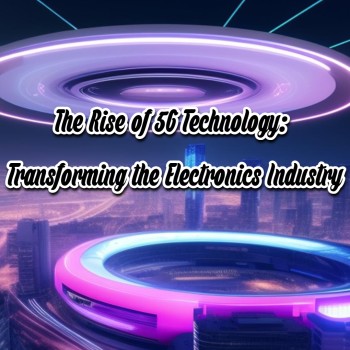The increasing adoption of fifth-generation wireless technology, or 5G, is driving a tremendous revolution in the electronics sector. This breakthrough development in connection catalyzes significant changes across many industries, not just quicker internet on our smartphones. In this post, we shall go deeper into the effects of 5G on the electronics industry.
Blistering Data Speed:
The astounding data speed of 5G is by far the most obvious and immediate effect. 5G is approximately 100 times faster than 4G, with a maximum speed of 20 gigabits per second. Both consumers and businesses will benefit greatly from this enormous increase in speed. It allows lag-free online gaming, ultra-fast file downloads, and smooth 4K and 8K video streaming.
This results in a rising demand for 5G-capable gadgets from electronics producers. The race is on to create and sell gaming consoles, laptops, tablets, and smartphones that are 5G-capable. As a result, technological advancement in the electronics sector is speeding up, enabling the development of cutting-edge products that fully utilize 5G connectivity.

Empowering the Internet of Things (IoT):
The Internet of Things revolution is powered by 5G. It is the ideal infrastructure for the constantly growing network of smart devices due to its low latency and capacity to link many devices at once. The powerful connectivity of 5G enables the rapid expansion of IoT across various applications, including smart homes, autonomous vehicles, industrial equipment, and medical devices.
This creates a fantastic opportunity for electronics producers. They are now working on various IoT gadgets, including connected appliances, autonomous drones, wearable health trackers, and smart thermostats. IoT ecosystem-compatible gadgets are in high demand, altering the market’s product landscape and spurring innovation.

Enabling Edge Computing:
Edge computing, a revolutionary strategy that moves data processing near to the data source, is being made possible by 5G’s low latency as well as high-speed capabilities. This is especially important for real-time data analysis-intensive applications like autonomous driving, augmented reality, and virtual reality (VR).
As a response, electronics producers are creating specialized edge devices that can manage sophisticated computations locally. The productivity of data-intensive applications is increased while data security and privacy are strengthened because there is less need for data to travel across large distances to centralized data centers.

Faster Data Rates:
The significant rise in data rates has had the most visible effect of 5G on the electronics sector. 5G is approximately 100 times faster than 4G, with download rates of up to 20 gigabits per second. Both individuals and organizations can explore new possibilities thanks to this lightning-fast communication. One example of the improved experiences offered by 5G is the flawless streaming of 4K and even 8K videos, the lightning-fast downloading of large files, and lag-free gaming.
This increases the need for gadgets that can fully utilize 5G, which is good news for electronics producers. Gaming consoles, computers, tablets, and smartphones are all vying for 5G connectivity, fostering innovation and competitiveness in the market.

5G in Agriculture:
A breakthrough era in agriculture is about to begin thanks to 5G technology, which will drastically alter how farming operations are carried out. Modern agriculture requires real-time monitoring solutions, which 5G provides with its low latency and high bandwidth capabilities. Farmers can make informed decisions thanks to the exact data that IoT sensors powered by 5G networks provide on soil quality, moisture content, and crop health. Farmers are able to precisely administer fertilizers, insecticides, and water, minimizing waste and maximizing yields, thanks to this precision, which also applies to resource management.
Furthermore, 5G technology makes it possible to use autonomous farming equipment, which can function more effectively and safely, cutting labor costs and increasing production. When connected with 5G connectivity, drones become essential resources for aerial photography, crop monitoring, as well as crop spraying.

Conclusion:
In conclusion, the development of 5G technology is revolutionizing many aspects of the electronics sector. The introduction of edge computing and its profound effects on numerous industries, together with 5G’s blazing data speeds, are all altering the electronics industry. We should expect even more revolutionary developments and opportunities as 5G networks continue to develop and grow. The adoption of this technology by consumers and businesses portends a future in which connectivity is quicker, smarter, and more seamlessly interwoven into our daily lives, and in which industries are improved. The 5G adventure for the electronics industry is just getting started, and the opportunities are endless.
More Posts:


Heya excellent blog! Does running a blog such as this take a massive amount work? I have absolutely no expertise in coding however I had been hoping to start my own blog soon. Anyways, if you have any suggestions or tips for new blog owners please share. I know this is off topic but I just needed to ask. Many thanks!
Mavis Morgan
Paige Hodge